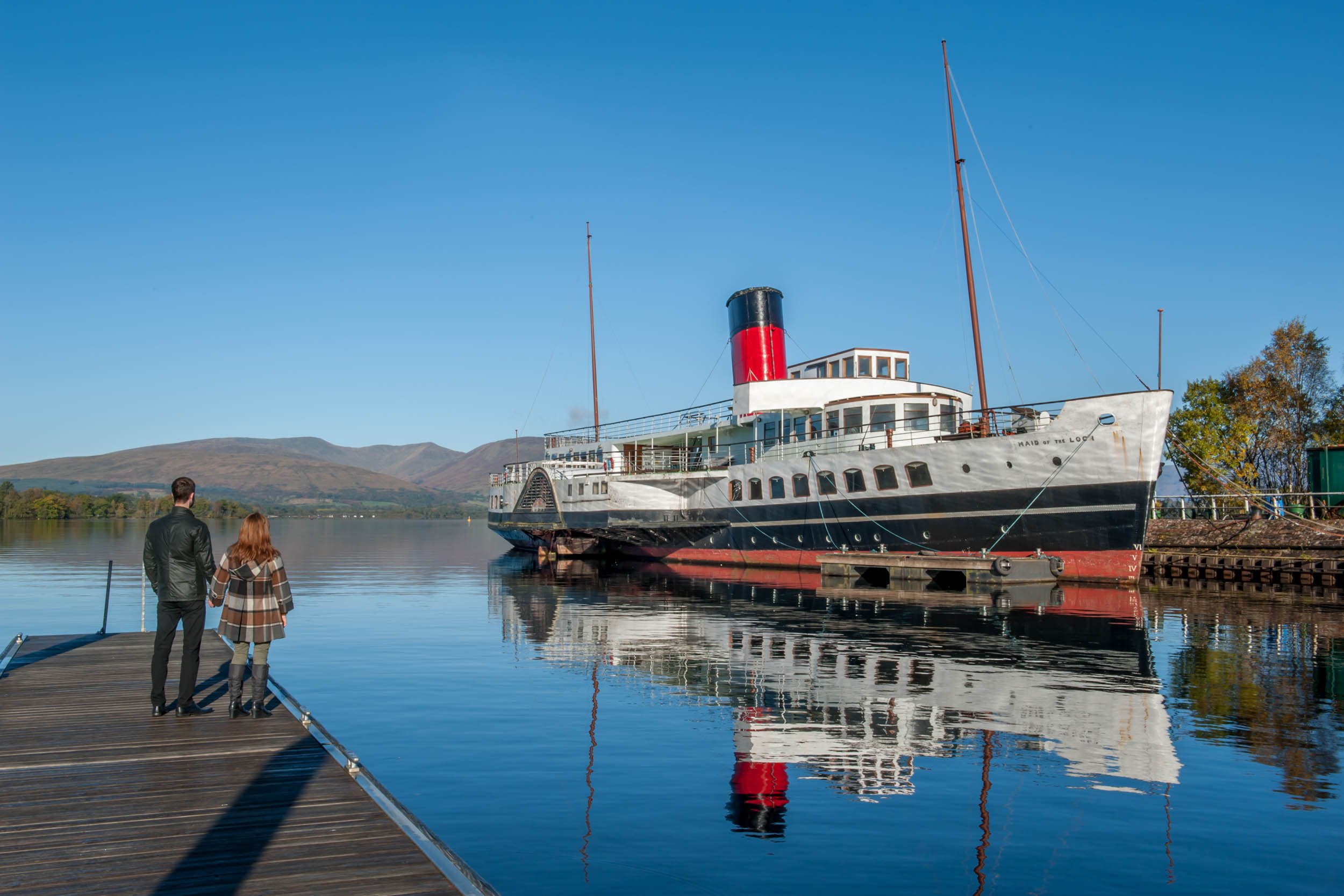South & East Loch Lomond
For long the gateway to Loch Lomond, Balloch’s role was further confirmed with the opening of Loch Lomond Shores as a focus and orientation for visitors to the Loch Lomond area. The view north up the loch is a backdrop to a wide-ranging high-quality shopping choice, as well as a range of places to eat, plus the Loch Lomond Aquarium in Drumkinnon Tower, with its own commanding panorama and a range of activities in the lagoon.
There is a boat-launching facility nearby, at the Duncan Mills Memorial Slipway, with the Maid of the Loch paddle steamer adjacent. This was the last paddle steamer built in the UK (on the Clyde). She was built in sections then shipped (by rail) to Balloch and re-assembled. The Maid is open to visitors regularly, there are periodic steam open days and it is hoped that she will be able to be fully restored to sail again in the future.
Sweeney’s Cruises operate a series of regular cruises from Balloch and in summer, there are water bus connections linking Balmaha, Luss and Balloch. Balloch Castle Country Park, Loch Lomond Shores and Cameron House also have ferry links on Loch Lomond.
Balloch Castle Country Park has woodland and lochside walks. The early 19th-century Balloch Castle has some stonework taken from the original castle of the Earls of Lennox –the site their original 13th-century castle is just a mound in the grounds today.

Aber Shore

Balmaha

Cashel Forest

Drymen

Rowardennan

Buchanan Castle Ruins
If travelling eastwards round the loch, Gartocharn, on the A811, is an attractive little community giving access to the loch shores via the Aber Path, with its views over the Loch Lomond National Nature reserve by the mouth of the Endrick Water. Alternatively, there is a broader, wider view of the loch to be enjoyed after a short walk up Duncryne, sometimes referred to as ‘The Dumpling, which is conspicuous just behind the village. (Limited parking.)
The attractive village of Drymen lies on what was once the lowest fording point of the Endrick Water and is a gateway for the east side of Loch Lomond. Strategically important even in Roman times, Drymen also was on the military road from Stirling to Dumbarton, built as part of a controlling policy for the Highlands. In more peaceable times, Drymen, with its ‘village green’ ambience and choice of pubs and places to eat and stay, became a favourite with visitors en route both to the loch and to the Trossachs. The West Highland Way, the Rob Roy Way and National Cycle Route 7 all pass though.
With its grounds a popular golf course, the roofless Buchanan Castle is still a local landmark and is associated with the Clan Graham. (While in use as a hospital in WWII, Rudolph Hess, Hitler’s deputy, was taken there after his mysterious flight and parachute jump.) The castle and Loch Lomond can be glimpsed from a viewpoint on a short pathway due north from the Buchanan Arms Hotel.
Balmaha, on Loch Lomond’s east shore, is tucked beneath the distinct humped profile of Conic Hill. Here the geological boundary, the Highland Line, runs down to the loch, as does the West Highland Way at this point. Balmaha on its little bay is made even more picturesque by the first of the characteristic Loch Lomond oakwoods. These woodlands have played a part in local iron-smelting, while later their bark was harvested for tannin, used in Glasgow’s tanneries.
Today, Balmaha is a noted anchorage, and Macfarlane’s Boatyard has over a century and a half’s experience of the loch and its vessels. Among other services, it offers cruises and a ferry service to the island of Inchcailloch. A National Park Visitor Centre offers displays and information for visitors and there is a choice of walks including the easy Balmaha Millennium Forest Path.
As a reminder that Lowland industry once penetrated this far, there was formerly a ‘liquor works’ at Balmaha, preparing pyroligneous acid from local timber for the making of the dyes used in the Vale of Leven textile activities.
The road to Rowardennan is popular with visitors and busy in peak season. On the way, Cashel Forest is signed – a project that aims to recreate a native woodland by Loch Lomond. There is a choice of waymarked walks. Only a little way beyond is the Ben Lomond Memorial Park, a protected area intended as war memorial to Scots servicemen. The area includes Ben Lomond, one of Scotland’s best known mountains, which is now owned and managed for the nation by the National Trust for Scotland. There are more walking options at Sallochy Wood, with fine loch views.
Eight miles (13km) beyond Balmaha, Rowardennan marks the end of the motorable road with a large carpark that is a popular starting point for the ascent of Ben Lomond and offers a choice of other walks. There is a youth hostel here.
The West Highland Way continues up the lochside to Inversnaid, otherwise reached by road via Aberfoyle and Stronachlachar and also by ferries from Inveruglas. The comparatively large hotel here is a reminder of how visitors used to flow through this area before the days of the car: train to Balloch, steamer to Inversnaid, coach to Stronachlachar, steamer to Trossachs pier, coach to Callander and train back! This was a popular day excursion in Victorian times and after. Today, there are still cruising services both on Loch Lomond and Loch Katrine.
Inversnaid is associated with the poet Gerald Manley Hopkins who, inspired by the waterfall here, was moved to make a plea for wild places in his poem Inversnaid. The oakwoods hereabouts also form an important part of a Royal Society for the Protection of the Birds nature reserve. (Pied flycatchers a summer speciality!)
Beyond Inversnaid, the West Highland Way continues through the lochside woodlands, passing above Rob Roy’s Cave. Later, and opposite Ardlui, the Way rises to a superb viewpoint, southwards down the loch, by the little hill of Cnap Mor.

